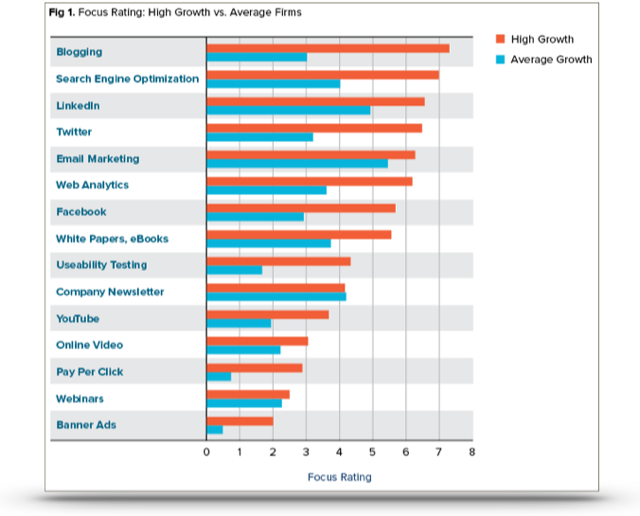We all know the Internet has changed the way businesses interact with their clients. Gone are the days when corporations held all the power in the relationship, dictating what’s best for the consumer. Today, with the explosion of social media channels such as LinkedIn, Twitter, Facebook, and Google+, the relationship has become more equitable. Social networks have allowed consumers the ability to interact directly with businesses and to share their experiences with each other as never before. But is your firm adequately leveraging social media strategies?
In a recent study we conducted on online marketing at Hinge, our marketing firm specializing in the professional services industry, we found that although many businesses have social media accounts, few utilize them to their full capabilities. Bottom line? If your firm isn’t taking advantage of social media, you’re losing major opportunities to engage with your clients in their space. And if you’re not going to engage them, another firm will.
What high growth firms do differently
We also uncovered some big differences in the online marketing activities of high growth firms versus average growth firms. High growth firms were much more likely to have solid social media strategies in place, incorporating the major social platforms to create brand awareness and to build customer relationships. In fact, out of 15 online marketing tools, high growth firms ranked Twitter and LinkedIn as their third and fourth most useful tools, with Facebook coming in at seventh. High growth companies also tended to rate social media tools as highly effective at meeting business objectives, whereas average growth companies did not.

Where to Start
High growth firms are using social media strategies, but they’re also selective about their usage. They know that social media is a big investment; it takes time, dedication, and resources to manage campaigns across the many social platforms available. Average growth firms often make the mistake of trying to do it all, but it’s not necessary to be on every channel. In fact, it’s better to interact frequently on a few select channels, rather than having many accounts that you don’t have time to monitor. The first step is understanding which platforms make sense for your specific business. There’s been a lot written on the various social networks, but let’s briefly review each platform’s strengths and weaknesses for the professional services industry.
LinkedIn
Many consider LinkedIn to be the social network for professional services. With a population of educated executives and businesspeople, this social network has much more of a professional feel than Facebook. Strengths: Its ability to put you in touch with like-minded industry experts, whether for recruitment or content sharing. Utilize groups to share and interact, with the ultimate goal of establishing yourself as an industry thought leader. With the ability to create a company page and promote blog posts, LinkedIn is a great way to share content. Weaknesses: Its lack of media variety, with less focus on rich media such as video and pictures.Facebook
Facebook is by far the most popular social network in the world. With a casual feel and a personal focus, Facebook is great for getting a peek into friends’ personal lives and hobbies.
Strengths: Allowing for rich media and content sharing, Facebook is strong where LinkedIn is weak. Facebook provides companies an opportunity to interact with clients and potential clients. In order to fully utilize its capabilities, you should focus on capturing your company culture by adding:
- A video tour of the office
- Interviews with team members
- Special events like birthdays or milestones
- Updates on news and events
- Job postings
Weaknesses: Its casual atmosphere makes Facebook less of a platform to become a thought leader and more of a way to become friends with customers. Better suited in many ways for B2C.
A community of micro-bloggers, Twitter connects strangers who are interested in similar topics, enabling them to strike up conversations out of thin air.
Strengths: Twitter can be a great asset for B2B firms, helping you stay plugged in to your industry’s pipeline. By following the right people, you’ll get up-to-date information from conversations happening in the moment. It’s a great way to connect with thought leaders in your industry and develop professional relationships with them. Utilizing Twitter to tweet content on your site is an effective way to generate traffic, promote content, and start conversations. Note: Twitter is highly reciprocal, and sharing others’ content is vital to proper use. Don’t just tweet about yourself.
Weaknesses: Twitter is great for reaching a single audience, but reaching across numerous industries, demographics, and interests becomes difficult. Because tweets are limited to 140 characters, it can be difficult to generate deeper conversations.
Google+
This rapidly growing social network is Google’s response to Facebook, with similar user profiles, news feeds, and an emphasis on rich media.
Strengths: Although similar to Facebook, Google+ has some features that Facebook does not, such as:
- Hangouts, which allow screen-sharing and are great for directly connecting with others.
- Communities, which are similar to LinkedIn groups and allow for ongoing discussions.
- Advanced Photos allows for advanced photo editing.
Integrating aspects of both Facebook and Twitter, Google+ is a great way to share content and develop relationships. Google+ was initially popular primarily with tech first adopters, making it a natural fit for high tech B2B firms. Another good reason to consider Google+ is that Google owns it; if you want to rank on Google, it certainly can’t hurt to utilize their platform in your social media strategy.
Weaknesses: Because it is a newer social media platform, Google+ is still in the process of growing its user base. Users are generally younger and tech-focused, so executives and decision makers are less likely to utilize it.
Don’t miss the party
Personal relationships have always been integral to growing professional services businesses, and social media offers a powerful and inexpensive way to make this happen on a much larger scale. High growth firms have already realized this, jumping into social media marketing with both feet. The takeaway? Don’t miss the social media party—if you are not there, you can bet that your competitors will be.
[et_social_share]







2 comments
Comments are closed.